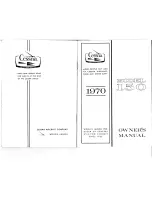
ARROW II
PROPELLER SERVICE
The spinner and backing plate should be cleaned and inspected frequently for cracks. The
propeller should be inspected before each flight for nicks, scratches and corrosion. If found,
they should be taken care of as soon as possible by a rated mechanic, because nicks and
scratches cause areas of increased stress which can cause serious damage or loss of a propeller
tip. The back face of the blades should be painted when necessary with flat black paint to retard
glare to the pilot's eyes. To prevent corrosion the surface should be cleaned and waxed
periodically.
OIL REQUIREMENTS
The oil capacity of the Lycoming engine is 8 quarts with a minimum safe quantity of 2
quarts. It is recommended that engine oil be drained and renewed every 50 hours or sooner
under unfavorable conditions. Intervals between oil changes can be increased as much as 100
percent on engines equipped with full flow cartridge type oil filters provided the element is
replaced each 50 hours of operation. The following grades are required for temperatures:
Temperatures above 60
°
F
Temperatures between 30 ° F and 90 ° F
Temperatures between O ° F and 70 ° F
Temperatures below 10 ° F
FUEL SYSTEM
S.A.E. 50
S.A.E. 40
S.A.E. 30
S.A.E. 20
The fuel screens in the strainer and the injector will require cleaning every 50 hour
inspection. The screen in the injector
is
located in the housing where the fuel inlet line connects
to the injector. The fuel strainer, located ahead of the firewall,
is
accessible for cleaning by
removal of the lower cowl. When the strainers are reassembled after cleaning, a small amount of
grease applied to the gasket will facilitate assembly.
FUEL REQUIREMENTS
A minimum octane of 100/130 Aviation Grade fuel must be used in the Arrow II.
Since the use of lower grades of fuel can cause serious damage in a short period of time,
the engine warranty is invalidated by use of lower octanes.
FILLING FUEL TANKS
Observe all required precautions for handHng gasoline. Fill the fuel tanks to the
bottom of the filler neck. Each wing tank holds a maximum of 25 gallons, giving a total of
50 gallons of fuel.
HANDLING AND SERVICING
ISSUED: November 1S, 1971
9-7
N16422 POH








































